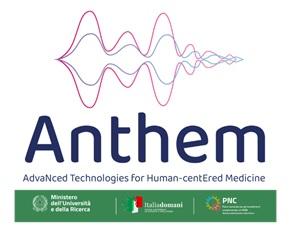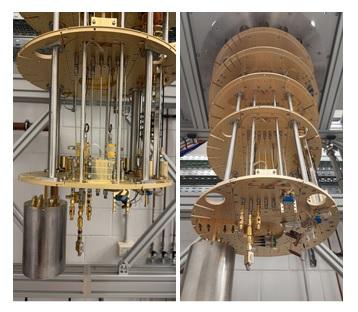PNRR Projects

ANTHEM - Advanced Technologies for Human-centred Medicine - is an initiative funded by the Ministry of University and Research as part of the "National Plan for Complementary Investments to the PNRR" (PNC - National Complementary Plan). ANTHEM aims to fill, with the help of innovative, multidisciplinary technologies and pathways, the existing gap in healthcare for frail and chronic patients in specific areas characterized by orphan diseases.
The Department of Physics' contribution focuses on achieving some of the key objectives of Spokes 1 and 2.
Spoke 1: Data and technology-driven diagnosis and therapies
Contribution to pilots 1.6 and 1.8
The Department's research is aimed at developing algorithms and models to extract diagnostic information from heterogeneous clinical data and to optimize and simplify the treatment of chronic diseases (particularly oncology and cardiac diseases). It also develops prototypes and technologies to support diagnostics, contributing to the creation of an advanced high-spatial-resolution Positron Emission Tomography (PET-TOF) system and the development of virtual tissue histology to expand and improve the diagnostic capabilities of conventional histology.
Spoke 2: Connecting patients and therapists through adaptive environments and intelligent sensors to enhance proximity medicine.
Contribution to pilots 2.1, 2.3, 2.4, and 2.5
The Department's research focuses on the development of wearable sensors (e.g., patches for monitoring measurable biochemical markers, breathing monitoring devices, virtual/augmented reality technologies) for real-time monitoring of both patient clinical parameters and the environmental risks implicated in the onset of pathological conditions in fragile and chronically ill populations.
It also focuses on the generation of technological platforms for the control of biological risk contamination (i.e., state-of-the-art lighting and systems for sanitizing surfaces and environments contaminated by microbial pathogens) and their use concerning information relating to the entire patient management process (from triage to the treatment plan). Finally, it is involved in the development of nanosensors for the detection of pathogens and biological agents.

MUSA - Multilayered Urban Sustainability Action focuses on the sustainable development of Italy’s main metropolitan area, which is among the top in Europe in terms of GDP.
This area is home to a wide variety of high-value-added manufacturing activities, advanced services, and financial sectors.
Why an innovation ecosystem?
MUSA aims creating the conditions to facilitate the transition of the urban environment towards a sustainable innovation ecosystem through actions that address various environmental and social risk factors, providing local institutions with solid foundations for evidence-based policies.
The ecosystem approach considers the collective knowledge, skills, perspectives, and interests of all the stakeholders present in the territory (public institutions, civil society associations, research centers, and businesses) and their relationships.
The main resource behind the project is a partnership of scientific and industrial excellence, with complementary knowledge and expertise that will help tackle this ambitious path.
MUSA is organized into SPOKEs as outlined in this diagram.
The Department of Physics is involved in 4 SPOKEs: 1, 3, 5, and 6.
Spoke 1 - Urban Regeneration City of Tomorrow
This spoke features a Joint Lab with the aerospace industry Thales Alenia Space Italia. It develops space technologies with multidisciplinary applications, particularly in digital electronics (innovative onboard computers) and analog electronics (ultra-scaled MEMS technology miniature accelerometers), microfluidics applications, and mission studies for the calibration of ground-based radio telescopes.
Spoke 3 - Deep Tech: Entrepreneurship & Technology Transfer
Two Joint Labs have been activated in this spoke with companies INFINEON and HUAWEI. The goal is to establish permanent infrastructures with these industrial partners to support both academic research and the creation of high-tech startups that develop innovative product lines. Specifically, with INFINEON, semiconductor products are being developed focusing on high efficiency to reduce energy consumption. With HUAWEI, the aim is to develop microwave and millimeter-wave devices. In this regard, at the WELab, specialized equipment is used to characterize ultra-high- frequency circuital elements, creating an accurate library for designing integrated circuits up to 200 GHz.
Spoke 5 – Sustainable Fashion, Luxury, and Design
In this spoke, the Department of Physics is active through actions related to the plasma surface treatment of special fabrics for fashion and high-tech purposes, aiming at enhancing comfort, fit, and water repellency.
Spoke 6 – Innovation for Sustainable and Inclusive Societies
Inclusivity and sustainability also pass through cultural initiatives. In this sense, as part of this SPOKE, we have initiated continuous training for teachers at all school levels (from kindergarten to high school) in STEM (Science, Technology, Engineering, Mathematics) disciplines, inspired by the evocative theme of the sky. This initiative has trained over 200 teachers and 6,000 students within the Milan network and its surrounding areas. Additionally, an exhibition titled “Sky Observers: Italian Stories of Science, Technology, and People,” in collaboration with Thales, has been set up at the central library of the university.

The National Research Center in High Performance Computing, Big Data and Quantum Computing (ICSC) was established by the National Recovery and Resilience Plan (PNRR) to maintain and enhance the Italian HPC and Big Data infrastructure. Its mission is to
develop methods, applications, and advanced software tools for the computation, the simulation, the collection and the analysis of the data of interest for the research, the production, and the social systems also through cloud and distributed approaches.
The Supercomputing Center is a consortium of universities, of public and private research institutions and organisations, and of private companies spread across the country. It engages and promotes the best interdisciplinary skills in science and engineering, fostering substantial and sustainable innovation in fields ranging from basic research to computational and experimental sciences for climate, the environment, and the space, from the study of matter and life to medicine, from materials technologies to information systems and devices. The center supports higher education and promotes the development of policies for responsible data management, embracing open data and open science, combining regulatory, standardisation, and compliance aspects. The National Center provides a shared and open cloud/HPC infrastructure, which represents a unique strategic asset for Italy and the international community. It aims to become an innovative ecosystem serving the country and attracting international attention, strengthening Italy's competitiveness and contributing to European leadership in the sector.

As part of the national NQSTI program, the University of Milano-Bicocca is leading the Spoke 6 "Integration" , dedicated to the development of integrated quantum systems for quantum computing, simulation, and sensing.
Within Spoke6, the Department of Physics group is primarily active in the design and simulation of superconducting quantum devices, as well as their characterization at very low temperatures using the Cryogenics Laboratory's dilution refrigerators, recently upgraded thanks to NQSTI funding. The group also contributes to the development of control electronics for quantum systems, including the associated firmware.
For the fabrication of the designed devices, the group collaborates with strategic partners such as the Bruno Kessler Foundation (FBK) in Trento and the National Institute for Metrological Research (INRIM) in Torino, in addition to maintaining an active collaboration with the National Institute of Standards and Technology (NIST) in Boulder, Colorado (USA).
Integrated Superconducting Platforms
In collaboration with INFN and FBK, the group develops integrated platforms for quantum sensing, with applications such as axion detection. Activities include the development of superconducting qubits coupled to planar or 3D resonators, traveling-wave parametric amplifiers (TWPAs) for multiplexed readout of many qubits, and RFSoC-based systems with FPGAs for the manipulation and readout of quantum states.
Thanks to the Spoke6 open calls, the Universities of Salerno, Milano, and INRIM have also joined the collaboration.
The goal is to develop prototypes of superconducting quantum systems with TRL 4, oriented towards technological applications, in line with the objectives of NQSTI Spoke 7.
Cross-Platform Quantum Systems
The group is also participating in the development of hybrid systems integrating photonic and superconducting platforms, in collaboration with INFN, CNR, FBK, INRIM, and the University of Salerno. Expected results include prototypes for both microwave and near-infrared/UV photon detection using superconducting detectors with photon number resolution, and the generation of nonclassical photonic states via TWPA.
In synergy with the Department's Bicoq Excellence Project, the group is also exploring the integration of bulk-acoustic wave (BAW) mechanical resonators with superconducting systems, combining quantum sensing and metrology techniques to overcome the standard quantum limit.
New Superconducting Materials
In collaboration with the Department of Materials Science, the group is studying new superconducting materials for the construction of TWPAs and qubits, with the aim of improving their performance and reliability.
Quantum Applications in Spoke7
The Department of Physics is also involved in NQSTI's Spoke 7 project, which focuses on the development of complete, application-oriented quantum systems.
In this context, the Biophysics group is studying the integration of a two-photon scanning microscope with a SPAD array detector to perform measurements using a quantum-inspired Image Scanning Microscopy (ISM) approach. This scheme allows for an increase in spatial resolution of approximately 50%, opening up new perspectives for high-precision imaging.